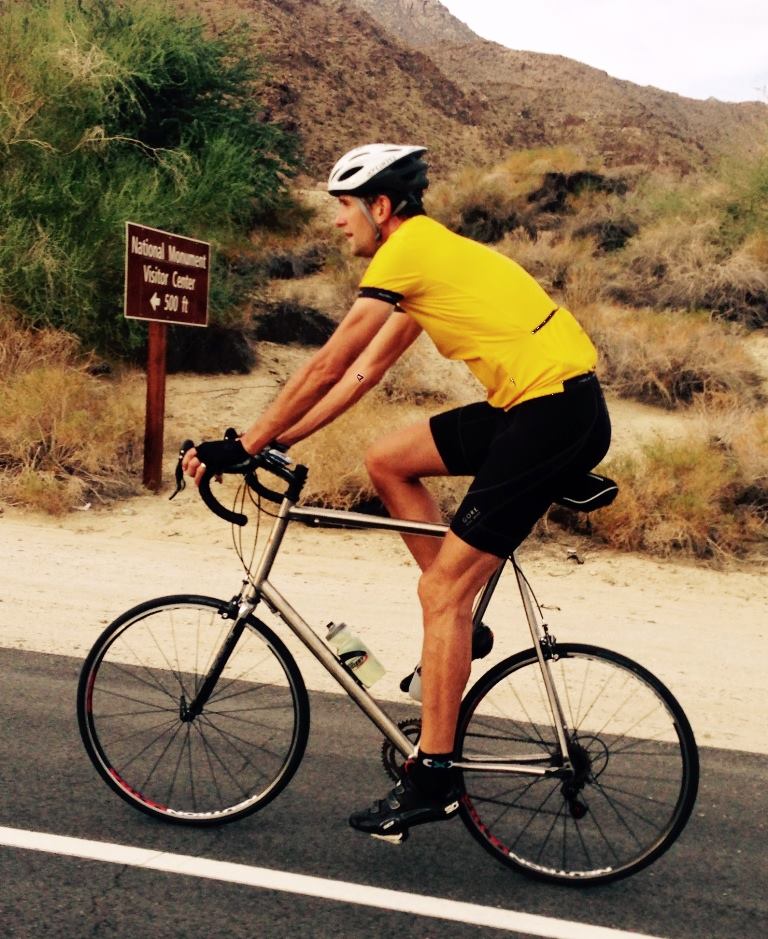Height affects performance in most sports. This is particularly true for competitive cycling.
During cycling, the contraction of muscles supplies the propulsion while wind resistance (drag) heads progress. The former is related to cross sectional area while the latter, surface area. Given both are related to a form of area, they would at first appear to offset one another as the body scales. However, drag scales to a lesser extent due to streamlining, thereby giving the taller cyclist an advantage on flat courses1. Hence, time trialists in the Tour de France tend to be among the tallest within the sport.
The work done by gravity is more varied as it resists and assists progress on ascending and descending, respectively, while it is minimal on the flats. And given the force of gravity scales more quickly with body height than do muscular force and drag (square-cube law), the taller person will be at a disadvantage when ascending and advantage when descending. Of the two, the disadvantage during climbing tends to have the greater impact on race outcomes, perhaps because the equalizing factor of drafting is mostly absent at the slower speeds at which climbing occurs.
Drafting in general favors the shorter rider as they fit more completely into another rider’s slip stream. Another critical aspect of competitive cycling is accelerations, which shorter riders tend to excel at due to increased strength in relation to their mass (once again, square-cube law). Accelerations can occur when coming out of a turn, as riders jockey for position, or from attempts to ‘drop’ competitors. Two more advantages for shorter cyclists are aerobic and heat dissipation proficiency.
In all around competitions such as a grand tour, all of these factors come into play, and form an inverted U-shaped height curve. Those who find themselves on the podium tend to be near the peak of this curve.
Despite the many advantages of short stature, there have been some above average height winners of the Tour de France in recent years: 6′1″ Andy Shleck, 6′3″ Bradly Wiggins, and 6′1″ Chris Froome. What these riders have in common is their exceptionally long limbed and lean bodies (just over 150 lbs). The relatively low body mass for better climbing, high surface area for better cooling, low frontal profile for lesser drag, yet long legs for generating power, all play to the cyclist’s advantage. The very tallest riders in cycling must abide by such proportions to the extreme. For example, 6′6″ Johan Van Summeren weighs only 168 lbs.
Beyond the physical aspects of the body, however, success in cycling requires extraordinary perseverance and determination. It is a grueling endurance sport, and only those who can ride through pain, train relentlessly to perfect technique, and maintain consistency stand a chance. It is this that explains why some cyclists, despite the obvious disadvantage of their size, such as Johan Van Summeren, have somehow found their way onto the podium.
- Swain DP, Coast JR, Clifford PS, Milliken MC, Stray-Gundersen J. Influence of body size on oxygen consumption during bicycling. J Appl Physiol. 1987;62.


Awesome power to weight ratio
Geez, no mention of Miguel Indurain???
5 time TdF winner and even held the World Hour record at 6’2″…
Whoops, good call!
Well what about Marcel Kittel? He’s 188cm, about 6’3, and weighs 82 kg, or 180 pounds.
I enjoy mountain biking but certainly feel a disadvantage when it comes to tight turns, uphill acceleration, and confidant fast braking. The laws of physics are against me with a far higher center of gravity than average sized riders. I am 6’2″ with a 36″ inseam. I struggle to find a bike that fits well with long legs without feeling overextended on the handlebar reach. There is certainly a lot that can be done to customize a bike’s set up, but that certainly adds up.
So my take is as a person who in his 20’s played basketball in college, built myself a 6’6″ 250 lb frame with lots of muscle throughout, then in early 40’s gets a bad knee injuries, surgeries etc. Well they cant put humpty dumpty back together so I pick up cycling. Now at 58, with plenty of competiveness inside me, I compare strava to my age group, I’m at the botton because at a lean 244 lb. I still weigh almost twice the average male cyclist, and in weight class, most of the fellas are almost 1/2 my age. I should compete with myself alone and be satisfied. What Id like is and age and wt combined group, comparison in strava. I still love biking and I want to ride all I can, so ultimately thats what is important.
Strava and the like really ought to better deal with height variations, but I don’t think it will happen for the same reasons we don’t fit properly in cars (Economy of Scale). So perhaps we take matters into our own hands and come up with an equation to ‘adjust’ our weight for the virtual world.
I think your relationship with cycling is the same I would have with basketball (if I played). I’m 5’ 7” with a 130lb lean frame (140-145 if I eat too much) and cycling is the only sport I can think of where I don’t have a disadvantage right off the bat. Basketball, soccer, hockey, volleyball, tennis etc all demand tall frames. Many also require more musculature.
I still get destroyed in crosswinds but very few can touch me in a hill sprint. Climbing isn’t the end of the world for me, either.
I guess I’m grateful that there exists some sport where my genetics aren’t considered objectively inferior 🙂
A lot more advantages than just cycling, check out some of Thomas Samaras’ work, you’ll be intrigued.